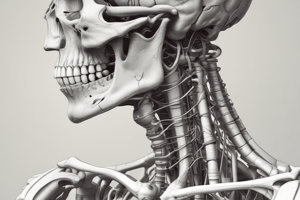Podcast
Questions and Answers
Match the type of synovial joint with its description:
Match the type of synovial joint with its description:
Hinge Joint = Allows movement in only one plane, like a door hinge. Ball and Socket Joint = Offers a wide range of motion in multiple directions. Pivot Joint = Allows rotation around a single axis. Condyloid Joint = Permits movement in two planes, but not rotation.
Match the anatomical plane with its description:
Match the anatomical plane with its description:
Sagittal = Divides the body into right and left. Frontal/Coronal = Divides the body into anterior and posterior (front and back) Transverse = Not mentioned. None = Not mentioned.
Match the connective tissue with its function:
Match the connective tissue with its function:
Tendons = Connect bones to other bones. Ligaments = Connect muscles to bones. Cartilage = Acts as a cushion between bones. None = Not mentioned.
Match the type of blood vessel with its description:
Match the type of blood vessel with its description:
Match the type of joint with its example:
Match the type of joint with its example:
Match the following bone types with their descriptions:
Match the following bone types with their descriptions:
Match the following training principles with their definitions:
Match the following training principles with their definitions:
Match the following acute responses to their descriptions:
Match the following acute responses to their descriptions:
Match the following chronic adaptations to their descriptions:
Match the following chronic adaptations to their descriptions:
Match the following methods of performance enhancement with their descriptions:
Match the following methods of performance enhancement with their descriptions:
Flashcards are hidden until you start studying
Study Notes
Synovial Joints
- Hinge Joints: allow movement in one plane, e.g. elbow joint
- Ball and Socket Joints: offer a wide range of motion in multiple directions, e.g. shoulder joint
- Pivot Joints: allow rotation around a single axis, e.g. neck joint (atlantoaxial joint)
- Condyloid Joints: permit movement in two planes, but not rotation, e.g. wrist joint
- Saddle Joints: enable movement in two planes with greater freedom than condyloid joints, e.g. thumb joint (first carpometacarpal joint)
- Gliding Joints: facilitate sliding or gliding movements between bones, e.g. carpals of the wrist
Body Planes
- Sagittal Plane: divides the body into right and left
- Frontal/Coronal Plane: divides the body into anterior and posterior (front and back)
Tendons, Ligaments, and Cartilage
- Tendons: connect muscles to bones, transmitting muscle force to produce movement
- Ligaments: connect bones to other bones, providing stability and preventing excessive movement in joints
- Cartilage: acts as a cushion between bones, reducing friction and absorbing shock, while also providing structural support and aiding in joint movement
Blood Vessels
- Arteries: large, thick-walled blood vessels that carry blood away from the heart
- Veins: thinner than arteries, carrying blood back towards the heart
- Capillaries: tiny blood vessels where gas exchange occurs between cells and the cardiovascular system
Types of Bones
- Irregular Bones: irregularly shaped bones that don't fit into other categories
- Flat Bones: strong, flat plates of bone that typically provide protection
- Long Bones: longer than they are wide
- Short Bones: roughly the same width and length
- Sesamoid Bones: bones that sit fixed within a tendon
Heart Rate, Stroke Volume, and Cardiac Output
- Heart rate x stroke volume = cardiac output, showing how heartbeats and blood pumped per beat affect total blood flow
Legal Performance Enhancements
- Methods include proper nutrition, hydration, adequate rest, strength training, altitude training, and specialized equipment, all within the rules and regulations of sports organizations
Principles of Training Programs
- Specificity: training tailored to match the demands of the sport or activity
- Frequency: how often you train per week
- Intensity: level of effort during exercise
- Time: duration of each training session
- Type: specific exercises or activities included
- Progression: gradually increasing training difficulty
- Individuality: recognizing unique responses to training
- Diminishing Returns: rate of improvement slows over time
- Variety: incorporating diverse exercises
- Maintenance: sustaining fitness gains
- Overtraining: excessive training leading to harm
- Detraining: loss of gains when training stops
Acute Responses and Chronic Adaptations to Training
Acute Responses
- Increased Heart Rate (Cardiovascular)
- Elevated Respiration Rate (Respiratory)
- Muscle Fatigue (Muscular)
- Increased Blood Flow to Muscles (Cardiovascular)
Chronic Adaptations
- Muscular Hypertrophy (Muscular)
- Improved Cardiovascular Endurance (Cardiovascular)
- Increased Lung Capacity (Respiratory)
- Enhanced Recovery (Muscular/Cardiovascular)
Studying That Suits You
Use AI to generate personalized quizzes and flashcards to suit your learning preferences.




